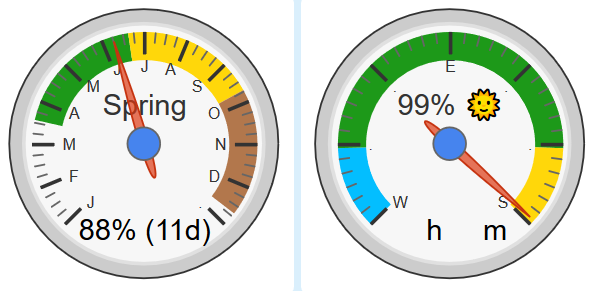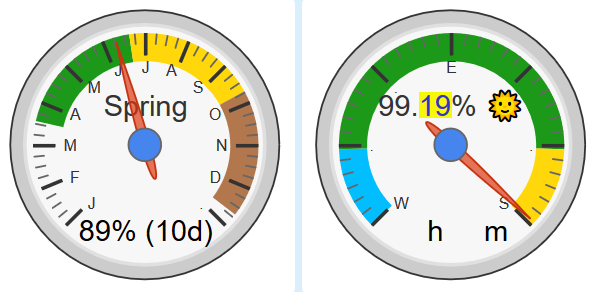I finally got around to creating this…now I need to find some time to create the gauges…
Now my wife will say I have over 14 hours of daylight to do work around the house. 

I finally got around to creating this…now I need to find some time to create the gauges…
Now my wife will say I have over 14 hours of daylight to do work around the house. 
Sorry about this unintended side-effect, LOL
If it helps, here is my latest snippet for my gauge: (using the ‘Value’ field)
[chart-gauge min=0 max=100 greenFrom=0 greenTo=16 greenColor={colorWin} yellowFrom=16 yellowTo=84 yellowColor={colorYel} redFrom=84 redTo=100 redColor={colorSum} minorTicks=6 majorTicks=W…E…S|{dlpR}%  ]
]
{colorWin} and {colorSum} are static, while
{colorYel} changes based on what day of the year it is… Something like:
(isBetween(doy,172,356) ? 'colorFall' : 'colorSpring')
{dlpR} is actually {dlp} rounded…
isBetween(dlp,1,99) ? round(dlp,1) : round(dlp,2)
It shows a single decimal most of the year, but two decimals from 0-1% and 99-100%.
Let me know @Koyfam if you need any help setting this up…
It is definitely one of my favorite pistons…

(the references above are for the right gauge… with time removed for privacy)
I may definitely take you up on this offer. I’ll plaY around with it first and reach out if I get stuck or have questions.
I admit, I feel bad I have not uploaded a piston’s import code to draw those gauges… My complexity in that piston has reached a high level of personalization at this point, so I am unable to share it.
(For example: It pulls extra data from a private API, and references @globals that you do not have)
To share it here, I would have to copy it, and strip out 90% of the code first.
(would you guys even want this?)
I mean technically, it is only a single line of code to draw a gauge… Mine only got complicated because I wanted a different color for Spring / Fall. If you don’t care about that, it is literally just a single line of code referencing that @dayLengthPercent global.
In my defense, when I normally share pistons publicly, I try to do it after extensive testing, but before personalizing them to my household. (IE: You guys in the forums never see my final draft)
In this particular case, my gauge piston advanced too far before I was happy with it…
… and when I was happy with it, it was already too personal to share.
I just wanted to showcase this code snippet in action…
This tweak uses 1 decimal most of the year, but switches to 2 decimals during the slow time period.
(typically the 10 days on either side of the Solstices)
Monday:

Tuesday:

(note the real @dlp was 98.996% here)
Wednesday:

(the double decimals should linger for about 20 days, then switch back to a single digit)
Essentially, this gives me precision when I need it most, and a great birds-eye-view for the rest of the year.
Not sure if my math may be off but I’m already at 100% daylight. I got a basic gauge to work. Need to fine tune it.
If you are using $sunset and $sunrise for times, it always rounds down.
(IE: 6:30:59 is displayed as 6:30)
This removes a tad bit of accuracy…
For what it’s worth, sticking with the simple $sunset and $sunrise times should keep you within about 0.5% of total accuracy. (it depends on your latitude… My worst case last year was off 0.42%)
I am currently using:
$twcweather.conditions.sunriseTimeLocal
$twcweather.conditions.sunsetTimeLocal
which brings in actual seconds.
(although it requires a bit more math to calculate)
I still had your prior calculation piston using $sunrise/$sunset. I assume the extra calculations is just converting the ISO time to a regular datetime? Since it is Local, does that mean I don’t need the tzOffset? thanks.
FYI: When I put these calculations in my dlp when from 99.33% to 99.66%. More than just what I would expect from 3am to now.
In this case, I don’t use dateTime… I use a time variable. (set by another piston)
IE:
time @sunrise 6:47:19 AM
time @sunset 7:12:47 PM
but the key element to this whole piston is converting (sunset - sunrise) into seconds.
(we need to know how many seconds the sun is above the horizon… Snippet below)
That is correct. All of the math is within a single day.
(which is automatically compared to your yearly expectations)
Here is a tiny snippet referring to my @global:

{cur} is a string, and {secNow} is an integer…
For example, 7:03:06pm - 6am = 13:03:06
then we want (6) + (3 * 60) + (13 * 3600) = 46,986 seconds of sunlight
That is an acceptable level of margin using floor rounded minutes.
Mine is now within 0.04% accuracy using the seconds of sunrise and sunset.
Remember, this @dlp percent only changes once a day…
You can run it at 1am, noon and 11pm, and the daily numbers will all be the same.
OK, got it now. Funny I forgot abut the machinations required to get seconds into the time variable. When I first put in the TWC sunrise and sunset it was still truncating the seconds. I updated to this:
Which gives me the full time and now I am back to 99.32%. So the old calculation was only off by 0.01%.
I see what you are doing here… You are letting webCoRE floor the minute, then just add the final seconds afterwards.
Slick.
(although it does triple the calls to $twcweather)
I thought these were just variables. I know they update periodically but assumed they were just static otherwise. Does each reference to $twcweather make some sort of call? I had a different implementation that stuck the values into intermediate variables and processed on that but I didn’t think it made a difference. That would do the same thing with just one ‘call’ for each value. I guess my other question is how do you convert to your sunrise/sunset variables from $twc given the time() conversion truncation?
From what I can see, every $twcweather command pulls fresh data…
(even if the data has not updated in awhile)
Two steps really. One piston runs daily and sticks the time into a global string:
… and then this piston takes that @global string, and does my previously mentioned math.
I mean, you could do both in the same piston… I just have mine set up to update at different times, with different parameters.
Pro Tip:
You probably want your @globals to only use a single @…
(not two like in my examples)
Sorry, I’m slow today. I think you showed here how you store the string {@@sunsetStr} and you showed above how you do calculations based on a time variable {@@sunset} but my problem was converting from a string to time as @@sunset=time(@@sunsetStr) would truncate the seconds. Was wondering if you had some trick other than what I did above to ensure you got the seconds.
I don’t think I converted the string into Time… I just went thru the work to go the other way…
(converting the time into a string, LOL)
Highlights from my earlier posts:
I set the global:
time @sunrise 6:47:19 AM
time @sunset 7:12:47 PM
Then I subtract those @global times and store in a string {cur}. (first line below)

Then I parsed the string… (second) + (minute * 60) + (hour * 3600) (last line above)
This tells us the exact number of seconds that the sun is above the horizon…
To answer this another way, here are the three steps I went with: (Time > String > Integer)
@sunrise = 6:47:19 AM and @sunset = 7:12:47 PM
{cur} = 13:18:29
{secNow} = 47909 <-- This is the number that is inputted into all of the other math(it could really be done in 1 or 2 steps, but I want the @global for other pistons to use, and {cur} is a great abbreviation for my piston state)
Notice I manually do the math in the last step to assure that the seconds are counted.
![]()
Using my {cur} example above, this is: (29) + (18 * 60) + (13 * 3600)
(If you let webCoRE calculate normally, you will loose the precious seconds, due to flooring… which probably explains your 0.01% variance)
As an alternative, I’ve been using a modified version of this piston to pull astronomical sunrise/set and conveniently they provide an day length integer in seconds.
As a backup, in case the API fails, I added the calculation using $twcweather data. Thanks for tip @WCmore to manually add each time component to ensure seconds are captured.
Now if I could only determine which is more accurate. When I compared the two data points, day length from the API is 30 seconds longer than the calculation using $twc data.
Since APIs come and go… (and free today does not mean free tomorrow)…
I prefer using reliable internal data, whenever possible.
(I cannot fathom SmartThings ever dropping sunrise and sunset times)
30 second difference could simply be the data is pulled from 10 miles away.
(IE: a shorter day could mean the sensor is farther north)
… or it could be rounding to the whole minute…
I would generally agree. Too bad the internal data ($sunrise $sunset) doesn’t include seconds. And whose to say they (ST) won’t decide to switch up the weather service again.
Guessing it’s a location issue, each data point pulls seconds regardless of method (No :00 data points). Sunrise differs by 12 seconds and sunset by 18. Not aignificnat enough to stress over but an interesting observation.
This gets me thinking…
IF both rise and set times are both shifted in the same direction…
(IE: both early, or both late)
then part of those values can represent a east/west shift.
(with the earlier location being farther east)
Using your example above, this could equate to 12 seconds east or west, and about 6 seconds north or south. (knights move in chess?)
I bet if you studied those variances for a few days, you’d be able to guesstimate where the reporting sensor(s) are located at. (just remember the variances are between the 2 stations… not your real location)